Don’t Ignore Horse Hooves in the Winter!

The opportunity to ride often decreases during the winter months, but just because a horse isn’t being ridden as much doesn’t mean that hoof care can be forgotten.
Cleaning
There are many issues which can take hold of the health of a hoof during the winter months, so it is imperative to examine the hoof carefully while cleaning. Types of problems that can arise include:
- Bruising
- Creates a buildup of pus in the sole caused after bruising foot on frozen ground
- Thrush
- Bacterial or fungal infection caused by standing in mud and on dirty bedding
The key is to help the horse by examining and picking the hooves out daily, and removing any mud or stones that could bruise the soles.
Trimming
A horse’s hooves do generally tend to grow at a slower pace during the winter, but cutting down or eliminating the trimming interval should be discussed with the animal’s veterinarian along with their farrier.
Shoeing
Horses that live outdoors do not usually require shoes. Sometimes, however, there are situations where shoes are a necessity, for example:
- To prevent excessive hoof wear
- To provide traction
- To prevent sole injuries
- For corrective and therapeutic use when an animal has orthopedic problems
Dependent upon the type of winter weather in an area, some owners make the decision to pull the shoes from their horses during the cold months. The decision to forego hoof care should never be done without first having a discussion with the veterinarian aand their farrier.
Owners of horses that typically wear shoes have three basic ways to consider using shoes on their animals in winter.
- Not at all – barefoot
- A barefoot horse typically has better traction on ground that is covered with snow and ice than a shod horse as the shoes increase the risk of slipping
- Allows the hooves to recover from having shoes on during the other parts of the year
- Removal of shoes may not be a good idea if the shoes are therapeutic or corrective or if the foot tends to bruise easily
- Bare hooves can be bruised on frozen ground
- Overgrown or poorly balanced hooves don’t provide good traction
- Shoes on front feet only:
- Usually done when front feet are shod for therapeutic reasons
- Bare hind feet will have better traction
- Difference in the traction from front to back feet may interfere with stride and cause an injury
- Shoes on all four feet:
- Shod horses run a bigger chance of getting ice and snow compacted in the hoof which will cause:
- Pain
- Bruising
- Increased pressure on tendons and joints
- Difficulty in walking
- Horses that must wear shoes can have snow pads or studs attached to the shoes that work to combat the snow compaction and reduce the chances of slipping
- To avoid injuries, some boarding facilities refuse to allow horses to wear hind shoes, or shoes with studs just in case the horse kicks another horse.
Hoof trimming in the winter can be done at longer intervals, about every six to twelve weeks, and is dependent on the horse, its use, its hoof condition, and its typical hoof growth. Since damage caused from walking on muddy and frozen ground can cause cracks, breakage, bruising, and loose shoes, it might be a good idea to maintain podiatry care throughout the winter.
For more information on equine care, contact your Covetrus representative today by calling 855.724.3461.


Working Here
Our team members are encouraged to be the best they can be... at Covetrus we believe we impact one another.
Learn MoreNews & Events
FDA Cautions Pet Owners Not to Feed Texas Tripe Inc. Raw Pet Food Due to Salmonella, Listeria Monocytogenes
The U.S. Food and Drug Administration is cautioning pet owners not to feed their pets any of the Texas Tripe brand raw frozen pet food listed below because several samples of Texas Tripe raw pet food have tested positive for Salmonella and/or L. mono.
Careers
Are you looking for a place to let your talents shine? At Covetrus, we help our practitioner customers better serve their patients and take pride in providing the best customer experience possible. Search our open positions to see our available opportunities.
Newsletter
Stay current with what’s going on with Covetrus, subscribe to receive our newsletter and email communications. Subscribers will receive the latest information in practice management, sales and marketing, animal health, and more.



-3-(1).png?sfvrsn=2d806d73_0)

Leave a comment